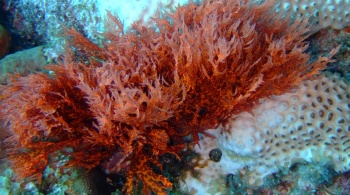Red Algae
From Wikiwel
Red algae are, not surprisingly, red, reddish or purplish in color. There are about 6,000 species of red algae (Source: AlgaeBase), and they are protists in the phylum Rhodophyta. Red algae species range from simple one-celled organisms to complex, multi-celled, plant-like organisms. Red algae get their energy from photosynthesis. One thing that distinguishes red algae from other algae is that their cells lack flagella.
Uses :
- Food : Two examples are nori, which is used in sushi, and Irish Moss, which can be made into pudding.
- to produce agars, which are gelatinous substances used as a food additive and in science labs as a culture medium.
See also :
Special Precautions of Red Algae
- Some seaweeds, such as Lithothamnium, may contain amounts of iodine, so people with thyroid problems should be careful.
- The disadvantage of using algae is that they can be loaded with heavy metals; after all, the seas and oceans are heavily polluted by capitalist exploitation of our planet. That is why only pure algae is used for phytotherapeutic application.
Health Benefits and uses of Red Algae are
- One benefit of red marine algae is its antioxidant effect, which counters damage free radicals do to cells.
- Red marine algae is also an anti-viral compound. The carrageenans -- a type of sugar molecule -- found in red marine algae are believed to boost interferon production in the immune system and might be an effective preventative against diseases like HIV, shingles and cold sores. According to the Disabled World website, your body can become resistant to certain prescription anti-viral medications, but red marine algae doesn't appear to have this flaw.
- promoted by supplements distributors to treat the herpes simplex virus.
- Anti-Virus : Red algae produce mannose-binding lectins, which allow the algae to protect themselves from invasion by viruses. Mannose-Binding lectins attack virus by a particular mechanism with which the body naturally breaks down and prevents infection from lethal infections including Ebola, HIV, HCV and SARS.
- The most promising form of mannose-binding lectins is a component of the Scytonema varium red algae called Scytovirin. The protein extract was isolated by researchers from the National Cancer Institute at Frederick, Maryland in 2003. The protein contains 95 amino acids, and was found to bind to HIV-1 viral shells.
- A similar antiviral protein was found in Nostoc ellipsosporum – called Cyanovirin-N. Both of these antiviral proteins did similar things – they broke down the glycoprotein shells of HIV and HCV.
- Yet another anti-viral extract was found from the New Zealand red alga species, Griffithsia sp. This protein is called Griffithsin, abbreviated with GRFT.
